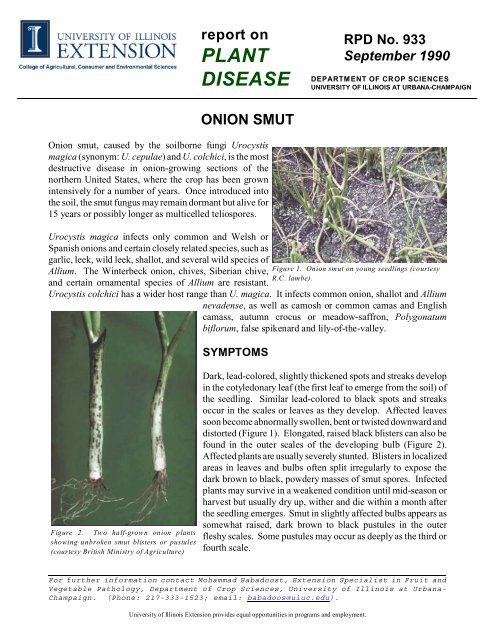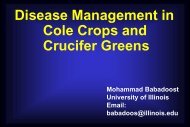Onion smut - Integrated Pest Management at the University of Illinois ...
Onion smut - Integrated Pest Management at the University of Illinois ...
Onion smut - Integrated Pest Management at the University of Illinois ...
You also want an ePaper? Increase the reach of your titles
YUMPU automatically turns print PDFs into web optimized ePapers that Google loves.
Figure 2. Two half-grown onion plants<br />
showing unbroken <strong>smut</strong> blisters or pustules<br />
(courtesy British Ministry <strong>of</strong> Agriculture)<br />
report on<br />
PLANT<br />
DISEASE<br />
ONION SMUT<br />
<strong>Onion</strong> <strong>smut</strong>, caused by <strong>the</strong> soilborne fungi Urocystis<br />
magica (synonym: U. cepulae) and U. colchici, is <strong>the</strong> most<br />
destructive disease in onion-growing sections <strong>of</strong> <strong>the</strong><br />
nor<strong>the</strong>rn United St<strong>at</strong>es, where <strong>the</strong> crop has been grown<br />
intensively for a number <strong>of</strong> years. Once introduced into<br />
<strong>the</strong> soil, <strong>the</strong> <strong>smut</strong> fungus may remain dormant but alive for<br />
15 years or possibly longer as multicelled teliospores.<br />
Urocystis magica infects only common and Welsh or<br />
Spanish onions and certain closely rel<strong>at</strong>ed species, such as<br />
garlic, leek, wild leek, shallot, and several wild species <strong>of</strong><br />
Allium. The Winterbeck onion, chives, Siberian chive,<br />
and certain ornamental species <strong>of</strong> Allium are resistant.<br />
Figure 1. <strong>Onion</strong> <strong>smut</strong> on young seedlings (courtesy<br />
R.C. lambe).<br />
Urocystis colchici has a wider host range than U. magica. It infects common onion, shallot and Allium<br />
nevadense, as well as camosh or common camas and English<br />
camass, autumn crocus or meadow-saffron, Polygon<strong>at</strong>um<br />
biflorum, false spikenard and lily-<strong>of</strong>-<strong>the</strong>-valley.<br />
SYMPTOMS<br />
Dark, lead-colored, slightly thickened spots and streaks develop<br />
in <strong>the</strong> cotyledonary leaf (<strong>the</strong> first leaf to emerge from <strong>the</strong> soil) <strong>of</strong><br />
<strong>the</strong> seedling. Similar lead-colored to black spots and streaks<br />
occur in <strong>the</strong> scales or leaves as <strong>the</strong>y develop. Affected leaves<br />
soon become abnormally swollen, bent or twisted downward and<br />
distorted (Figure 1). Elong<strong>at</strong>ed, raised black blisters can also be<br />
found in <strong>the</strong> outer scales <strong>of</strong> <strong>the</strong> developing bulb (Figure 2).<br />
Affected plants are usually severely stunted. Blisters in localized<br />
areas in leaves and bulbs <strong>of</strong>ten split irregularly to expose <strong>the</strong><br />
dark brown to black, powdery masses <strong>of</strong> <strong>smut</strong> spores. Infected<br />
plants may survive in a weakened condition until mid-season or<br />
harvest but usually dry up, wi<strong>the</strong>r and die within a month after<br />
<strong>the</strong> seedling emerges. Smut in slightly affected bulbs appears as<br />
somewh<strong>at</strong> raised, dark brown to black pustules in <strong>the</strong> outer<br />
fleshy scales. Some pustules may occur as deeply as <strong>the</strong> third or<br />
fourth scale.<br />
For fur<strong>the</strong>r inform<strong>at</strong>ion contact Mohammad Babadoost, Extension Specialist in Fruit and<br />
Vegetable P<strong>at</strong>hology, Department <strong>of</strong> Crop Sciences, <strong>University</strong> <strong>of</strong> <strong>Illinois</strong> <strong>at</strong> Urbana-<br />
Champaign. (Phone: 217-333-1523; email: babadoos@uiuc.edu).<br />
<strong>University</strong> <strong>of</strong> <strong>Illinois</strong> Extension provides equal opportunities in programs and employment.<br />
RPD No. 933<br />
September 1990<br />
DEPARTMENT OF CROP SCIENCES<br />
UNIVERSITY OF ILLINOIS AT URBANA-CHAMPAIGN
-2-<br />
Smut-infected bulbs shrink more rapidly in storage and are more susceptible than healthy ones to <strong>at</strong>tack<br />
by s<strong>of</strong>t rot-producing organisms. Very rarely, <strong>smut</strong>-infested leaves may come from a bulb infected during<br />
<strong>the</strong> previous season.<br />
DISEASE CYCLE<br />
The causal fungi are transmitted from one field to ano<strong>the</strong>r<br />
on infested bulbs and sets, by surface drainage w<strong>at</strong>er, by<br />
wind-blown soil, on tools or farm equipment, on <strong>the</strong> feet<br />
<strong>of</strong> humans, domestic animals and birds, or by any o<strong>the</strong>r<br />
agency th<strong>at</strong> transports soil. Although <strong>smut</strong> spores<br />
(multicelled teliospores) have occasionally been found on<br />
onion seed, spread <strong>of</strong> <strong>the</strong> causal fungi on <strong>the</strong> seed is not<br />
important. Diseased sets are probably <strong>the</strong> most common<br />
means <strong>of</strong> long-distance spread.<br />
The black, powdery masses <strong>of</strong> <strong>smut</strong> spores serve to<br />
propag<strong>at</strong>e <strong>the</strong> causal fungi. The microscopic spores are<br />
highly resistant to environmental changes and once<br />
incorpor<strong>at</strong>ed in <strong>the</strong> soil may remain alive for many years<br />
even in <strong>the</strong> absence <strong>of</strong> a susceptible host crop. The <strong>smut</strong><br />
Figure 3. Germin<strong>at</strong>ing teliospore <strong>of</strong> Urocystis magica,<br />
with a number <strong>of</strong> delic<strong>at</strong>e hyphae, as it would be seen<br />
under a high-power microscope (drawing by Lenore<br />
Gray).<br />
fungi can only penetr<strong>at</strong>e and infect <strong>the</strong> onion plant in <strong>the</strong> young seedling stage. If <strong>the</strong> cotyledon (outer<br />
seedling leaf) escapes infection until it is m<strong>at</strong>ure, no fur<strong>the</strong>r infection can occur even in heavily infested<br />
soil. Infection is possible only from <strong>the</strong> second or third day after <strong>the</strong> seed germin<strong>at</strong>es until <strong>the</strong> seedling<br />
is in first leaf and about three inches above ground, a period <strong>of</strong> 10 to 21 days. Healthy onion sets or<br />
transplants may be planted in <strong>smut</strong>-infested soil without danger <strong>of</strong> becoming infected.<br />
Smut teliospores germin<strong>at</strong>e by sending out delic<strong>at</strong>e hyphae (Figure 3) th<strong>at</strong> penetr<strong>at</strong>e <strong>the</strong> young cotyledon<br />
before it emerges. After emerging, <strong>the</strong> fungus obtains nourishment and grows through <strong>the</strong> cotyledon until<br />
it reaches <strong>the</strong> true leaves. Here <strong>the</strong> characteristic dark blisters appear just under <strong>the</strong> epidermis. L<strong>at</strong>er, <strong>the</strong><br />
blisters become filled with masses <strong>of</strong> black <strong>smut</strong> spores. When <strong>the</strong> pustules rupture, <strong>the</strong> spores drop,<br />
recontamin<strong>at</strong>e <strong>the</strong> soil, and are ready to start <strong>the</strong> disease cycle once again when an onion seed germin<strong>at</strong>es<br />
close by.<br />
Smut spores may germin<strong>at</strong>e and cause infection within <strong>the</strong> range <strong>of</strong> 50° and 78°F (10° to 25°C) with an<br />
optimum <strong>of</strong> 61° to 72°F (16° to 22°C). If <strong>the</strong> mean soil temper<strong>at</strong>ure is 84°F (28°C) or above when <strong>the</strong><br />
young seedlings are susceptible, no infection occurs. At slightly lower soil temper<strong>at</strong>ures, onion seedlings<br />
tend to outgrow <strong>the</strong> disease. These temper<strong>at</strong>ure rel<strong>at</strong>ions explain why <strong>smut</strong> is absent in sou<strong>the</strong>rn <strong>Illinois</strong><br />
and in winter onion-growing areas where <strong>the</strong> seed is sown in l<strong>at</strong>e summer.<br />
Soil moisture has no direct effect on spore germin<strong>at</strong>ion or <strong>the</strong> disease, but an excess <strong>of</strong> w<strong>at</strong>er in <strong>the</strong> soil<br />
generally means low temper<strong>at</strong>ure <strong>the</strong>re and slow growth, thus favoring <strong>the</strong> chances <strong>of</strong> <strong>at</strong>tack. The <strong>smut</strong><br />
fungi grow slowly in <strong>the</strong> soil, and contamin<strong>at</strong>ed areas do not rapidly enlarge when <strong>the</strong> soil is left<br />
undisturbed.
CONTROL<br />
-3-<br />
1. Where feasible, sow onion seed in noninfested soil or start onions from disease-free sets and<br />
transplants.<br />
2. All diseased seedlings and plants should, whenever possible, be collected and burned on <strong>the</strong> spot.<br />
Everything should be done to avoid <strong>the</strong> distribution <strong>of</strong> <strong>smut</strong>-infested soil.<br />
3. Tre<strong>at</strong> <strong>the</strong> seed with a seed-protectant fungicide. For details see Report on Plant Diseases No. 915,<br />
“Vegetable Seed Tre<strong>at</strong>ment.” Where onion maggot is destructive, a recommended insecticide<br />
should be added to <strong>the</strong> seed with <strong>the</strong> fungicide. Follow current recommend<strong>at</strong>ions <strong>of</strong> <strong>Illinois</strong><br />
Extension Entomologists or your nearest Extension <strong>of</strong>fice where a current copy <strong>of</strong> Circular 1373,<br />
<strong>Illinois</strong> Homeowners’ Guide to <strong>Pest</strong> <strong>Management</strong> is available. A properly applied seed-protectant<br />
fungicide also controls seed rot and damping-<strong>of</strong>f.<br />
a. For onion sets - Thoroughly mix <strong>the</strong> seed protectant with <strong>the</strong> dry seed before planting. Use 1<br />
pound <strong>of</strong> 100 percent active seed protectant to 20 pounds <strong>of</strong> seed. (This equals 1 1/4 pounds<br />
<strong>of</strong> 75 percent active or 2 pounds <strong>of</strong> 50 percent active to 20 pounds <strong>of</strong> seed).<br />
b. For bulb onions - Mix <strong>the</strong> seed-protectant fungicide with seed th<strong>at</strong> has been moistened with<br />
a 4 percent methyl-cellulose sticker (Methocel). Prepare by dissolving two ounces <strong>of</strong> Methocel<br />
in 1 quart <strong>of</strong> warm w<strong>at</strong>er. Let this solution stand overnight. Add it to 8 pounds <strong>of</strong> onion seed<br />
and stir vigorously for 1 or 2 minutes. Then add 8 pounds <strong>of</strong> 75 percent seed protectant (or 12<br />
pounds <strong>of</strong> 50 percent active fungicide). Tumble <strong>the</strong> seed for 4 or 5 minutes in a butter churn<br />
or barrel, an electric paint-can shaker, or a pelleting machine until it is uniformly co<strong>at</strong>ed with<br />
<strong>the</strong> dust. Then spread it out on fine screen wire to dry. Do not try to remove excess seed<br />
protectant. Several seed companies <strong>of</strong>fer this service free or on a custom basis. The r<strong>at</strong>e <strong>of</strong><br />
seeding should be adjusted to allow for <strong>the</strong> gre<strong>at</strong>er size <strong>of</strong> <strong>the</strong> pelleted seed.<br />
c. For pickling and green bunching onions - Same as for bulb onions, but use only half <strong>the</strong><br />
dosage <strong>of</strong> fungicide and sticker.<br />
4. Granular formul<strong>at</strong>ions are available to control <strong>smut</strong> and onion maggot. Be sure th<strong>at</strong> <strong>the</strong> granules<br />
contain both an insecticide and a seed-protectant fungicide. Carefully follow <strong>the</strong> manufacturer’s<br />
directions. Do not use pelleted seed in conjunction with granular applic<strong>at</strong>ions.<br />
Contact your nearest Extension <strong>of</strong>fice or ITCS, <strong>University</strong> <strong>of</strong> <strong>Illinois</strong> P345, 1917 S. Wright St.,<br />
Champaign, IL 61802 to obtain public<strong>at</strong>ions mentioned above.















